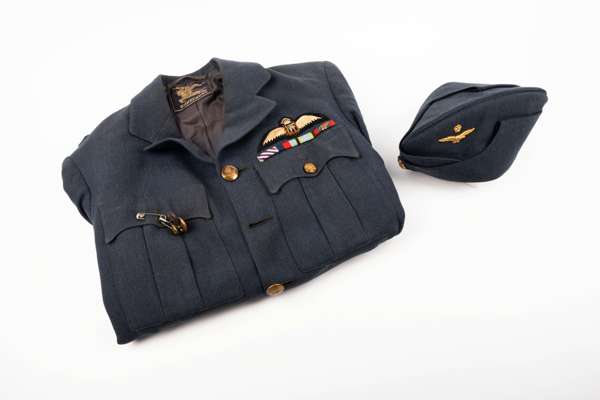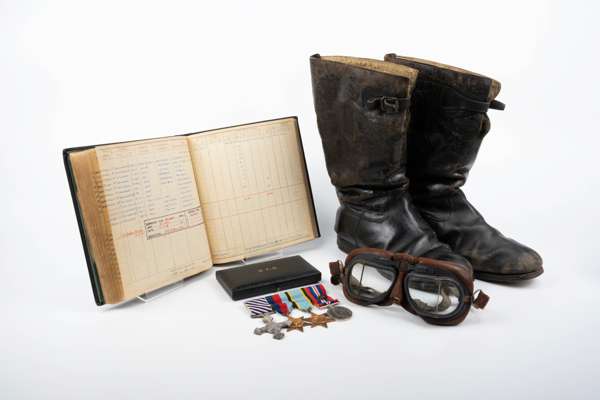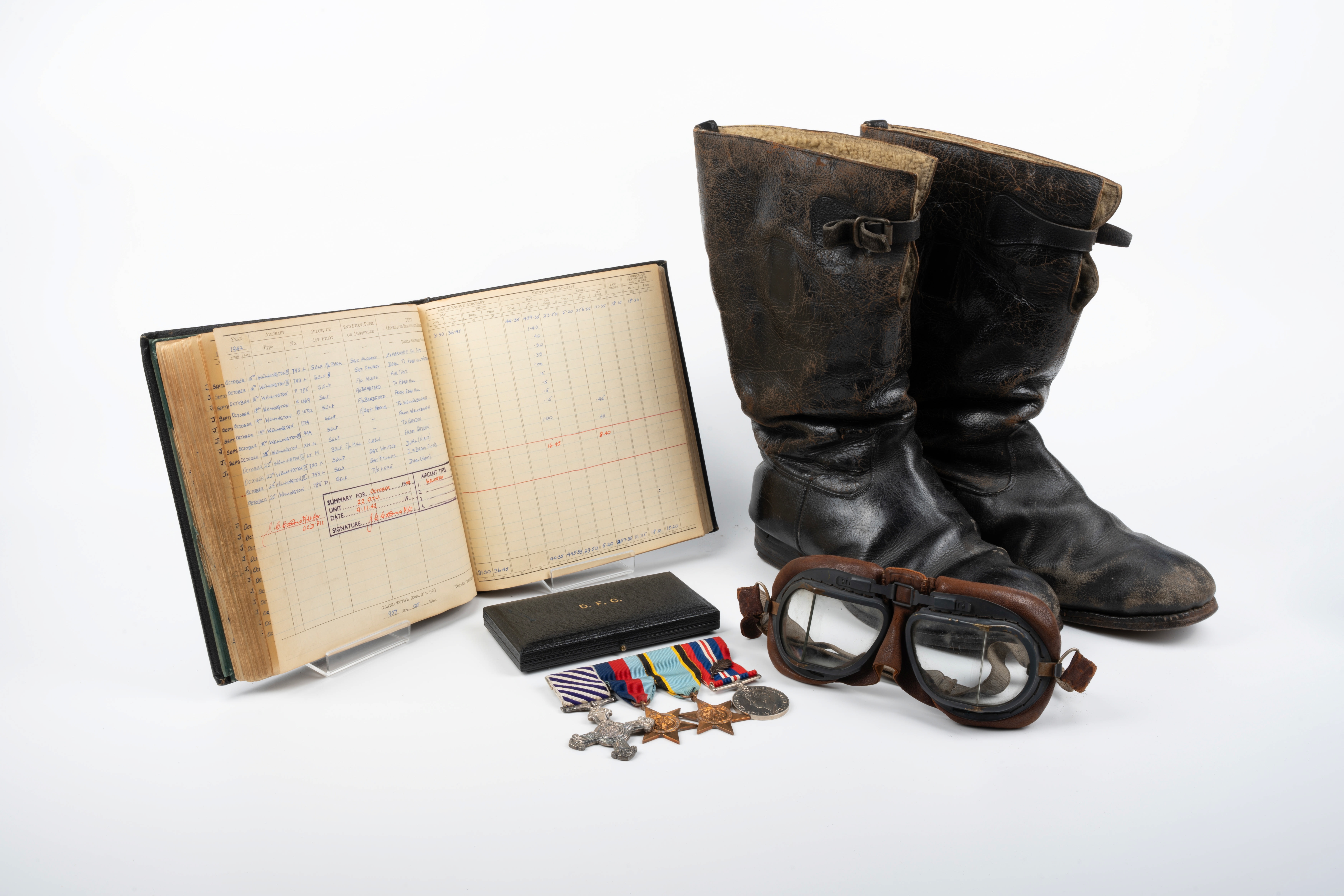
Lot 85
The Great Escape






"Behind The Wire" - Medal and Militaria Sale | M25001
Auction: 17 September 2025 at 14:00 BST
Description
The “Great Escape” Distinguished Flying Cross group of 4 awarded to Squadron Leader James “Peter” Cairns 429 (Bison) Squadron Royal Canadian Air Force who was shot down on the 27th April 1943 returning from a raid on Duisburg and was already out over the North Sea when a German night-fighter attacked his aircraft. Damage was sustained to the electrics and the intercom, and the second pilot was killed. Cairns turned the aircraft back towards the Dutch coast to give the surviving members of his crew a chance to bail out over land. But after a second attack, which left a wing and part of the fuselage on fire and their parachutes damaged and with two further members of his crew dead he opted to force land the aircraft. As he could see the runway lights of an aerodrome and headed straight for them but as the Wellington approached the lights were switched off, his aircraft overshot and crashed. Cairns was catapulted through the windscreen. He and two others were captured and after recovering from their injuries they spent the rest of the War as PoW's. During his time in captivity he would be interned the Famous Stalag Luft Three, and was in the hut from which the “Harry” the tunnel for the “Great Escape” was dug. Cairns was to be the last ,man to go down the tunnel before the hatch was closed. But the breakout was discovered before his turn came comprising. Distinguished Flying Cross, GVIR, officially dated (1940), 1939-45 Stra, Air Crew Europe Star, 1939-45 War Medal, with Mentioned in Despatches emblem, contemporarily mounted for wear, very fine (4)
Distinguished Flying Cross The London Gazette 22nd November 1940
Pilot Officer James Campbell Cairns (42692) RAF No 10 Squadron
Pilot Officer Cairns successfully completed fifteen operational missions as second Pilot, since then he has completed the following missions as Captain. The Fiat Works at Turin, Freiburg Aerodrome, The Electrical Equipment factory at Milan, the Synthetic Oil Plant at Dortmund, the chemical Explosives factory at Leverkusen, the aerodrome at Magdeburg, the Salzhof Oil Depot at Berlin and shipping and barges at Ostend. He has developed into a very successful Captain and his keenness has brought his crew to a high state of efficiency. He has shown great determination and courage in attacking his targets at low altitudes in the face f heavy opposition.
Mentioned in Despatches The London Gazette 1st January 1943
Newspaper Extract- Birmingham Evening Mail 2nd November 2002
James, known as “Peter” Cairns, from Berkswell, Solihull, was just 18 when he first flew in the war, and in a heroic career as a pilot he won several medals for his courage under enemy fire. Many daring wartime exploits define him as a true war hero, but his most spectacular came in 1943, when he crash landed his blazing Wellington at night on an enemy aerodrome, with every member of his crew either dead or wounded. He was captured at the scene of the crash and after a brief period in hospital, followed by interrogation, he was sent to Stalagluft 3 – the infamous German PoW camp. Peter Cairns’ hut was the very one from which the tunnel for Operation Escape 200 was dug in the spring of 1944. He was due to be the last man out, charged with shutting the trap door behind him, but the breakout was discovered before his turn came. This may have proved a blessing in disguise, however, as 50 of the 74 who did manage to escape were later recaptured and executed. He and his comrades’ actions in the breakout became known as The Great Escape and was later immortalised in the eponymous Hollywood classic, starring Steve McQueen and Donald Pleasance.
Whitley P5094 near Leeming airfield.
Around midnight on the night of 8th / 9th September 1940 the crew of this 10 Squadron aircraft had taken off for an operational flight to Oostende to bomb the harbour and shipping. Returning to Leeming at 04.53hrs with the hydraulics out of action and with no flaps or brakes the aircraft overshot on landing and ran onto the A1 road close to Leeming Lodge. The aircraft was damaged when it came to rest across the road in this overshoot and the pilot's leg had become broken and trapped. The crew were still to evacuate the aircraft when ten minutes later an electrical short circuit started a fire and the aircraft burst into flames. The pilot had suffered a broken left leg below the knee and was trapped in the cockpit, with the aircraft catching fire and fearing he would not be able to escape the burning aircraft he was pulled to safety through the top escape hatch by the wireless operator. It is highly likely that the wireless operator was awarded the DFM for his actions in pulling his pilot clear of the burning aircraft.
Whitley P5094 was built to contract 75147/38 by Armstrong Whitworth Ltd. at Baginton and was awaiting collection on 8th July 1940. It was delivered to 10 Squadron at Leeming a few days later. On 9th September 1940 it sustained the accident at Leeming and Cat. W/FB Burnt damage was later recorded after assessment.
Pilot - P/O James Campbell Cairns RAF (42692). Broken leg.
Second Pilot - Sgt Victor Snell RAFVR (745231).
Observer - P/O Frank Reginald Goddard RAFVR (78990).
Wireless Operator - Sgt Robert Edward Nicholson RAF (611204).
Air Gunner - Sgt Alexander Strachan Shand RAF (630244).
On 18th September 1940 Sgt's Snell, Nicholson and Shand were in Whitley P4957 which landed at the dummy airfield at Cold Kirby on the North Yorkshire Moors on return from Ops and the aircraft sustained damage, the incident is recorded on this website. Sgt Nicholson was awarded the DFM for service with 10 Squadron, Gazetted on 26th August 1941 but effective from 29th September 1940 (only days after the incident at Leeming recorded above and possibly an "immediate" DFM though as he was made a PoW there was probably no need to make the award of it too hurried). On the night of 30th September / 1st October 1940 Sgt Snell, Sgt Shand and Sgt Nicholson were flying in Whitley T4130 on Ops to Berlin when the aircraft was shot down over Germany. Sgt Snell was killed and Sgt's Shand and Nicholson were taken prisoner of war. Victor Snell was twenty six years old, he is buried in Reichswald Forest War Cemetery. I thank Graham Sharpe for the photograph of Sgt Snell's gravestone.
James "Peter" Cairns was born on 10th September 1921. He was barely out of school when he enlisted for RAF service in 1939 and after training was posted to 10 Squadron. Having survived the crash detailed above he spent some months in hospital recovering and then acted as an instructor before flying operationally again. He had received his commission to the rank of Acting Pilot Officer on probation on 18th September 1939, he was later graded as Pilot Officer on probation on 7th April 1940 and confirmed in the rank of P/Off on 24th July 1940. He was awarded the DFC, Gazetted on 22nd November 1940, though no citation for the award has been located. He rose to the rank of Flying Officer (War Subs) on 7th April 1941 and to Flight Lieutenant (War Subs) on 7th April 1942. He was Mentioned in Despatches on 1st January 1943. He had been posted from Wellesbourne (where he had instructed at the OTU) to 429 Squadron on their formation at East Moor in November 1942 and assumed command of B-Flight. He was promoted Acting Squadron Leader soon afterwards but 429 Squadron took some time to build up to operational readiness and they only flew their first operational flight in late-January 1943. Cairns flew his first with 429 Squadron on 16th February 1943.
On 27th April 1943 he was returning from a raid on Duisburg in Wellington HE737 at 13,000 feet and was already out over the North Sea when a German night-fighter attacked his aircraft. Damage was sustained to the electrics and the intercom, and the second pilot was killed. Cairns turned the aircraft back towards the Dutch coast to give the surviving members of his crew a chance to bail out over land. But after a second attack, which left a wing and part of the fuselage on fire and their parachutes damaged and with two further members of his crew dead he opted to force land the aircraft. As he could see the runway lights of an aerodrome and headed straight for them but as the Wellington approached the lights were switched off, his aircraft overshot and crashed. Cairns was catapulted through the windscreen. He and two others were captured and after recovering from their injuries they spent the rest of the War as PoW's. During his time in captivity he would spend time at the Luftwaffe run Prisoner of War Camp Stalag Luft Three, and was in the hut from which the tunnel code named “Harry” was dug for what was to become known as the “Great Escape” during the spring of 1944. He was due to be the last man out but the breakout was discovered before his turn came.
After liberation he returned to the UK and stayed in the RAF Reserve until the mid-1950s when he began working for the BBC working from Pebble Mill. He retired in 1982 but then worked for the Soldiers, Sailors, Airmen’s and Families Association (SSAFA), in Solihull and at their headquarters in London, and on 17th June 1995 he was appointed OBE while their Secretary. He died on 27th October 2002, aged 81.
Sold with Pilots Flying Log Book, Newspaper cuttings, 36 Pattern Flying Boots, MkVIII Flying Goggles, typed family history, Box for DFC. Original Draft of Times Obituary explaining his family nickname of “Peter”. Copt PoW Interrogation Report by the Gestapo. Framed Copy MiD Certificate mounted with Pilots Wings. Original Commission, letters and related ephemera. Service Dress Uniform, Peaked Cap and Glengarry. 1st Edition, 1952, War Crimes Trial Vol IX The Dulag Luft Trial edited by Eric Cuddon with a Note “Peter’s Evidence at the War Crimes Trial”. A harrowing story of being held in a cell for days at a time with the heating and lights on a 24 hours a day.






